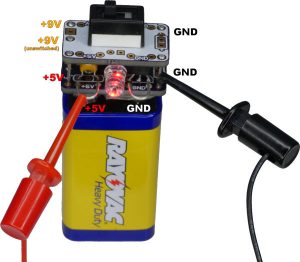I have a $500 Rigol DP832 programmable triple-output power supply sitting on my bench, yet I built a 5V regulator to sit atop a 9V battery for some reason. Perhaps it’s more portable, or cheap enough to toss in with the rest of the project it is powering, or maybe the bench power supply is just overkill. Or maybe, just maybe, I saw other people making them and I thought it would be cool to build myself.
Two boards were used to enclose the circuitry and to allow the power switch to stand out on its own. Also, the board connection pins are power points. So, you can use the hookup loops, board interconnect pins, header connectors, or wire holes to connect the power supply to your project.
The circuit is not fancy. It’s just a classic linear voltage regulator.
D1: Prevents damage due to connecting the battery backwards. Any small signal diode will do, because the current output of the TO-92-sized regulator is fairly low and the voltage drop between 9V and 5V is large enough to be unaffected by the diode voltage drop.
C1: 0.1 µF capacitor on the battery input
C2: 0.1 µF capacitor on the regulator output.
C2bulk: 1 µF or larger capacitor on the regulator output. All three capacitors stabilize the regulator output as the project consumes different levels of power during operation.
IC1: The voltage regulator that converts between the unregulated 9.6 volts to 7 volts from the battery into a steady 5 V or 3.3 V or whatever is desired.
R1: Resistor that limits the amount of current provided to LED1. Usually between 220 ohms and 470 ohms. In this case, LED1 is a flashing LED that does not need a current-limiting resistor, so a wire is used instead.
LED1: Power indicator LED. This is to avoid forgetting to turn off the regulator when not in use. The regulator uses a certain amount of power even when idle.
I chose a flashing LED in this case to draw more attention to the fact that the power supply is turned on. Also, a flashing LED uses less power than a steady LED, because a flashing LED is off part of the time.
Read more: 5V Regulator Cap for 9V battery

